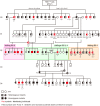Genetically engineered animal models for Marfan syndrome: challenges associated with the generation of pig models for diseases caused by haploinsufficiency
- PMID: 35598970
- PMCID: PMC9334321
- DOI: 10.1262/jrd.2022-027
Genetically engineered animal models for Marfan syndrome: challenges associated with the generation of pig models for diseases caused by haploinsufficiency
Abstract
Recent developments in reproductive biology have enabled the generation of genetically engineered pigs as models for inherited human diseases. Although a variety of such models for monogenic diseases are currently available, reproduction of human diseases caused by haploinsufficiency remains a major challenge. The present study compares the phenotypes of mouse and pig models of Marfan syndrome (MFS), with a special focus on the expressivity and penetrance of associated symptoms. Furthermore, investigation of the gene regulation mechanisms associated with haploinsufficiency will be of immense utility in developing faithful MFS pig models.
Keywords: Disease model pig; FBN1; Genetic engineering; Haploinsufficiency; Marfan syndrome.
Conflict of interest statement
There is no conflict of interest.
Figures


References
-
- Hardouin SN, Nagy A. Mouse models for human disease. Clin Genet 2000; 57: 237–244. - PubMed
-
- Rosenthal N, Brown S. The mouse ascending: perspectives for human-disease models. Nat Cell Biol 2007; 9: 993–999. - PubMed
-
- Rogers CS, Stoltz DA, Meyerholz DK, Ostedgaard LS, Rokhlina T, Taft PJ, Rogan MP, Pezzulo AA, Karp PH, Itani OA, Kabel AC, Wohlford-Lenane CL, Davis GJ, Hanfland RA, Smith TL, Samuel M, Wax D, Murphy CN, Rieke A, Whitworth K, Uc A, Starner TD, Brogden KA, Shilyansky J, McCray PB, Jr, Zabner J, Prather RS, Welsh MJ. Disruption of the CFTR gene produces a model of cystic fibrosis in newborn pigs. Science 2008; 321: 1837–1841. - PMC - PubMed

